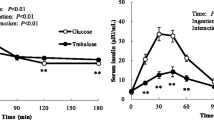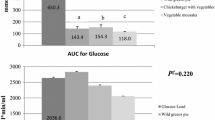Abstract
Background
Reducing the dietary glycaemic response has been proposed as a means of reducing the risk of diabetes.
Aim
To evaluate the effects of a new diabetes-specific formula (DSF) enriched with resistant starch type IV and fructose-free on postprandial glycaemia, insulinaemia and gastrointestinal hormones in healthy volunteers and in outpatient type 2 diabetics.
Methods
(1) Twenty-four healthy volunteers were divided into two groups: Group 1 ( n = 10) was provided 50 g of the carbohydrate (CHO) constituent of the new product and 50 g of glucose separated by 1 week; Group 2 ( n = 14) was provided 400 ml of the new DSF (T-Diet Plus® Diabet NP) and 400 ml of a control product separated by 1 week. (2) Ten type 2 diabetic patients received 400 ml of the new DSF and two other commercially available DSF (Glucerna® SR and Novasource® Diabet) on three occasions separated by 1 week. Venous blood samples were drawn at time 0 and at different times until 120 min. Glucose, insulin and gastrointestinal hormones were determined. Glycaemic and insulinaemic indices and glycaemic load were calculated.
Results
The CHO constituent and the new DSF showed low glycaemic index and glycaemic load. In healthy subjects, insulin and C-peptide release were lower after administration of the CHO constituent as well as after the new DSF (P < 0.001). Ghrelin, glucagon-like peptide-1 (GLP-1) and glucose-dependent insulinotropic peptide (GIP) production were lower after intake of the CHO constituent (P ranging from <0.001 to 0.019) compared with glucose, and GIP was lower after ingestion of the new DSF (P = 0.002) than after the control product. In type 2 diabetic patients, glucose AUC was lower after the administration of the new DSF (P = 0.037) compared with the others.
Conclusions
Our results indicate that this new product could be beneficial for diabetic patients.


Similar content being viewed by others
References
Diet, nutrition and the prevention of chronic diseases (2003) World Health Organ Tec Rep Ser 916:i–viii, 1–149
International Diabetes Federation (IDF) (2012). Diabetes Atlas, 4th edition. http://www.idf.org/diabetesatlas/downloads/backgroundpapers. Accessed 4 July 2012
Yamagishi SI, Nakamura K, Matsui T et al (2007) Role of postprandial hyperglycemia in cardiovascular disease in diabetes. Int J Clin Pract 61:83–87
Ceriello A, Davidson J, Hanefeld M, International Prandial Glucose Regulation Study Group et al (2006) Postprandial hyperglycaemia and cardiovascular complications of diabetes: an update. Nutr Metab Cardiovasc Dis 16:453–456
Bantle JP, Wylie-Rosett J, Albright AL et al (2006) Nutrition recommendations and interventions for diabetes-2006: a position of the American Diabetes Association. Diab Care 29:2140–2157
Wright J (1998) Effect of high-carbohydrate versus high-monounsaturated fatty acid diet on metabolic control in diabetes and hyperglycaemic patients. Clin Nutr 17:35–45
American Diabetes Association (2003) Evidence-based nutrition principles and recommendations for the treatment and prevention of diabetes and related complications. Diab Care 26:S51–S61
Brand-Miller J, Hayue S, Petocz P, Colagiuri S (2003) Low-glycaemic index diets in the management of diabetes. Diab Care 26:2261–2267
Ludwig DS (2002) The glycaemic index: physiological mechanisms relating to obesity, diabetes, and cardiovascular disease. JAMA 287:2414–2423
Jenkins DJ, Wolever TM, Taylor RH et al (1981) Glycaemic index of foods: a physiological basis for carbohydrate exchange. Am J Clin Nutr 34:362–366
Ostman EM, Liljeberg Elmståhl HG, Björck IM (2001) Inconsistency between glycaemic and insulinaemic responses to regular and fermented milk products. Am J Clin Nutr 74:96–100
Salmeron J, Ascherio A, Rimm EB et al (1997) Dietary fibre, glycaemic load, and risk of NIDDM in men. Diab Care 20:545–550
Monro JA, Shaw M (2008) Glycaemic impact, glycaemic glucose equivalents, glycaemic index, and glycaemic load: definitions, distinctions, and implications. Am J Clin Nutr 87:237S–243S
Elia M, Ceriello A, Laube H et al (2005) Enteral nutritional support and use of diabetes-specific formulas for patients with diabetes: a systematic review and meta-analysis. Diab Care 28:2267–2279
Wynne K, Stanley S, McGowan B, Bloom S (2005) Appetite control. J Endocrinol 184:291–318
Gallwitz B (2005) New therapeutic strategies for the treatment of type 2 diabetes mellitus based on incretins. Rev Diabet Stud 2:61–69
Chaudhri O, Small C, Bloom S (2006) Gastrointestinal hormones regulating appetite. Philos Trans R Soc Lond B Biol Sci 361:1187–1209
Shiiya T, Nakazato M, Mizuta M et al (2002) Plasma ghrelin levels in lean and obese humans and the effect of glucose on ghrelin secretion. J Clin Endocrinol Metab 87:240–244
Haber GB, Heaton KW, Murphy D, Burroughs LF (1977) Depletion and disruption of dietary fibre. Effects on satiety, plasma-glucose, and serum-insulin. Lancet 2:679–682
FAO (1998) Carbohydrates in human nutrition. Report of a Joint FAO/WHO Expert Consultation. Food Nutr Pap 66:1–140
Jenkins DJ, Kendall CW, Augustin LS et al (2002) Glycaemic index: overview of implications in health and disease. Am J Clin Nutr 76:266S–273S
Hofman Z, De Van Drunen J, Kuipers H (2006) The glycaemic index of standard and diabetes-specific enteral formulas. Asia Pac J Clin Nutr 15:412–417
Jarvi AE, Karlstrom BE, Granfeldt YE et al (1999) Improved glycaemic control and lipid profile and normalized fibrinolytic activity on a low-glycemic index diet in type 2 diabetic patients. Diab Care 22:10–18
Rizkalla SW, Taghrid L, Laromiguierre M et al (2004) Improved plasma glucose control, whole-body glucose utilization and lipid profile on a low-glycaemic index diet in type 2 diabetic men. Diab Care 27:1866–1872
Alish CJ, Garvey WT, Maki KC et al (2010) A diabetes-specific enteral formula improves glycaemic variability in patients with type 2 diabetes. Diabetes Technol Ther 12:419–425
Pohl M, Mayr P, Mertl-Roetzer M et al (2005) Glycaemic control in type II diabetic tube-fed patients with a new enteral formula low in carbohydrates and high in monounsaturated fatty acids: a randomized controlled trial. Eur J Clin Nutr 59:1221–1232
Voss AC, Maki KC, Garvey WT et al (2008) Effect of two carbohydrate-modified tube feeding formulas on metabolic responses. Nutrition 24:990–997
Björck I, Granfeldt Y, Liljeberg H et al (1994) Food properties affecting the digestion and absorption of carbohydrates. Am J Clin Nutr 59:699S–705S
Kelley DE (2003) Sugars and starch in the nutritional management of diabetes mellitus. Am J Clin Nutr 78:858S–864S
Tsang MW (2012) The management of type 2 diabetic patients with hypoglycaemic agents. ISRN Endocrinol. doi:10.5402/2012/478120
Kaur N, Gupta AK (2002) Applications of inulin and oligofructose in health and nutrition. J Biosci 27:703–714
Williams CM (1999) Effects of inulin on lipid parameters in humans. J Nutr 129:1471S–1473S
Wren AM, Seal LJ, Cohen MA et al (2001) Ghrelin enhances appetite and increases food intake in humans. J Clin Endocrinol Metab 86:5992
Nakagawa E, Nagaya N, Okumura H et al (2002) Hyperglycaemia suppresses the secretion of ghrelin, a novel growth-hormone releasing peptide: responses to the intravenous and oral administration of glucose. Clin Sci (Lond) 103:325–328
Saad MF, Bernaba B, Hwu CM et al (2002) Insulin regulates plasma ghrelin concentration. J Clin Endocrinol Metab 87:3997–4000
Sparti A, Milon H, Di Vetta V et al (2000) Effect of diets high or low in unavailable and slowly digestible carbohydrates on the pattern of 24-h substrate oxidation and feelings of hunger in humans. Am J Clin Nutr 72:1461–1468
Blundell J, de Graaf C, Hulshof T et al (2010) Appetite control: methodological aspects of the evaluation of foods. Obes Rev 11:251–270
Flint A, Raben A, Blundell JE et al (2000) Reproducibility, power and validity of visual analogue scales in assessment of appetite sensations in a single test meal studies. Int J Obes Relat Metab Disord 24:38–48
Acknowledgments
This work has been funded by a research contract no. 2964 between the Granada University-Business Foundation and Vegenat S.A. We thank all volunteers for their participation. Thanks to the staff from the UHVN for technical assistance and MT Miranda for statistical support. Vegenat S.A. sponsored the study and supplied the nutritional products.
Conflict of interest
The authors declare that they have no conflict of interest.
Author information
Authors and Affiliations
Corresponding author
Rights and permissions
About this article
Cite this article
García-Rodríguez, C.E., Mesa, M.D., Olza, J. et al. Postprandial glucose, insulin and gastrointestinal hormones in healthy and diabetic subjects fed a fructose-free and resistant starch type IV-enriched enteral formula. Eur J Nutr 52, 1569–1578 (2013). https://doi.org/10.1007/s00394-012-0462-x
Received:
Accepted:
Published:
Issue Date:
DOI: https://doi.org/10.1007/s00394-012-0462-x




